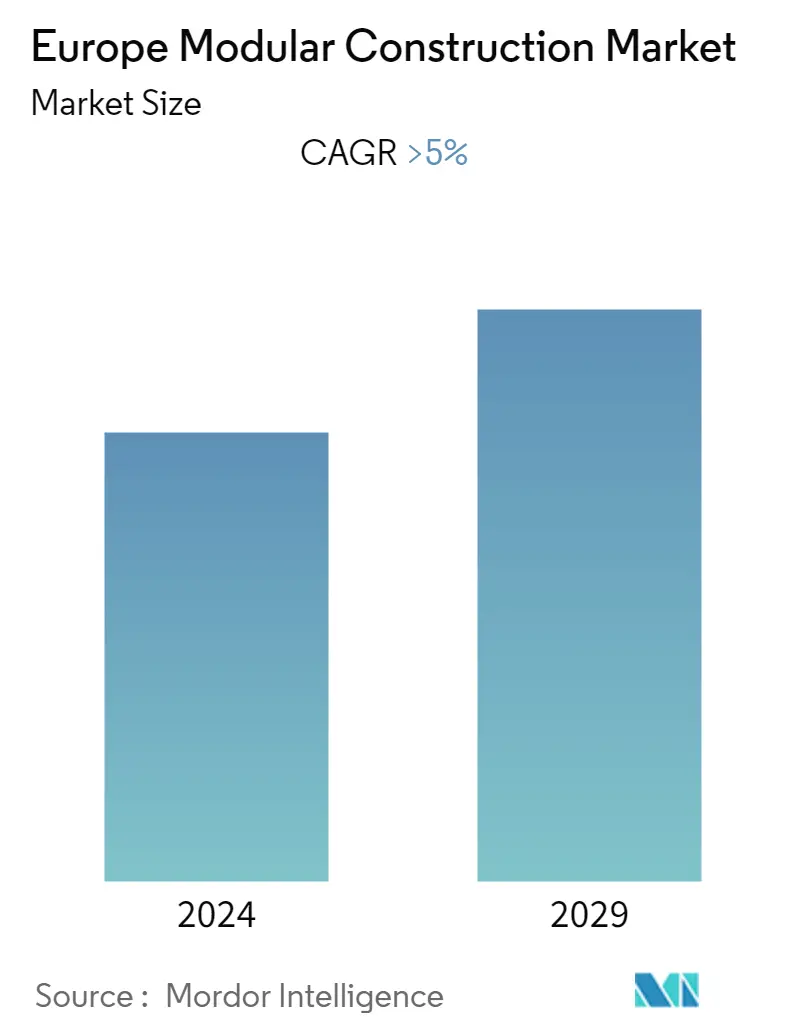Market Size of Europe Modular Construction Industry

| Study Period | 2021 - 2029 |
| Base Year For Estimation | 2023 |
| Forecast Data Period | 2024 - 2029 |
| Historical Data Period | 2021 - 2022 |
| CAGR | 5.00 % |
| Market Concentration | Low |
Major Players
*Disclaimer: Major Players sorted in no particular order |
European Modular Construction Market Analysis
The European modular construction market is estimated to reach USD 10332 million by the end of this year and is expected to grow at a CAGR of greater than 5% during the forecast period.
- The COVID-19 pandemic wreaked havoc on the economy, resulting in construction being halted and impacting labor-intensive sectors. The outbreak of the pandemic caused market turbulence and uncertainty across Europe. Furthermore, stock market volatility hurt manufacturer stock prices and trade volumes. As a result, new residential and non-residential development had declined significantly, reducing the demand for modular construction.
- The modular construction market is expected to grow because of the rising demand for permanent modular construction. This is because modular construction saves time and money compared to traditional construction.
- However, the higher initial funding required for setting up production on a huge scale and the high risk of project failure while shipping the finished construction model to the preferred site might pose a hindrance to the market's growth. Moreover, the impact of the recession could further weaken demand for modular construction across the European region.
- On the other hand, the growing need for higher-quality, eco-friendly homes all over the continent could be a chance for the modular construction market to grow.
- Germany is expected to lead the market for modular construction over the next few years because it has the biggest construction industry in Europe.
European Modular Construction Industry Segmentation
Modular construction is a construction technique that involves the prefabrication of 2D panels or 3D volumetric structures in off-site factories and transportation to construction sites for assembly. This process has the potential to be superior to traditional construction in terms of both time and cost. The Europe modular construction market is segmented by type, material, end-user, and by geography. By type, the market is segmented into permanent and relocatable. By material, the market is segmented into steel, concrete, wood, and plastic. By end-user the market is segmented into commercial, industrial/institutional, and residential. The report covers market sizes and forecasts for four major countries across the region. For each segment, the market sizing and forecast have been done on the basis of revenue (in USD million).
| Type | |
| Permanent | |
| Relocatable |
| Material | |
| Steel | |
| Concrete | |
| Wood | |
| Plastic |
| End-user Industry | |
| Commercial | |
| Industrial/Institutional | |
| Residential |
| Geography | |
| Germany | |
| United Kingdom | |
| France | |
| Italy | |
| Rest of Europe |
Europe Modular Construction Market Size Summary
The European modular construction market is poised for growth, driven by the increasing demand for permanent modular solutions that offer time and cost efficiencies over traditional construction methods. Despite the challenges posed by the COVID-19 pandemic, which led to significant disruptions in the construction sector and a decline in new development projects, the market is expected to recover and expand. The need for high-quality, eco-friendly housing across Europe presents a significant opportunity for modular construction. Germany, with its robust construction industry, is anticipated to lead the market, benefiting from a surge in residential construction and a growing preference for prefabricated housing solutions.
The commercial segment of the European modular construction market is also experiencing strong demand, particularly for modular office buildings and storage spaces, driven by the shift towards e-commerce and increased need for distribution hubs. The market is characterized by its fragmented nature, with numerous players such as Skanska, Modulaire Group, and DFH Group contributing to its dynamics. Strategic partnerships and projects, like the joint venture between Daiwa House and Capital Bay, are expected to further enhance the market's growth prospects. Overall, the European modular construction market is set to expand, supported by technological advancements and evolving consumer preferences.
Europe Modular Construction Market Size - Table of Contents
-
1. MARKET DYNAMICS
-
1.1 Drivers
-
1.1.1 Growing Demand for Modular Construction in Commercial Segment
-
1.1.2 Rising Demand for Higher-quality, Eco-friendly Homes
-
-
1.2 Restraints
-
1.2.1 Requirement of Substantial Initial Financing owing to Size and Scale of Production
-
1.2.2 Impact of Recession
-
-
1.3 Industry Value Chain Analysis
-
1.4 Porter's Five Forces Analysis
-
1.4.1 Bargaining Power of Suppliers
-
1.4.2 Bargaining Power of Buyers
-
1.4.3 Threat of New Entrants
-
1.4.4 Threat of Substitute Products and Services
-
1.4.5 Degree of Competition
-
-
-
2. MARKET SEGMENTATION (Market Size in Value)
-
2.1 Type
-
2.1.1 Permanent
-
2.1.2 Relocatable
-
-
2.2 Material
-
2.2.1 Steel
-
2.2.2 Concrete
-
2.2.3 Wood
-
2.2.4 Plastic
-
-
2.3 End-user Industry
-
2.3.1 Commercial
-
2.3.2 Industrial/Institutional
-
2.3.3 Residential
-
-
2.4 Geography
-
2.4.1 Germany
-
2.4.2 United Kingdom
-
2.4.3 France
-
2.4.4 Italy
-
2.4.5 Rest of Europe
-
-
Europe Modular Construction Market Size FAQs
What is the current Europe Modular Construction Market size?
The Europe Modular Construction Market is projected to register a CAGR of greater than 5% during the forecast period (2024-2029)
Who are the key players in Europe Modular Construction Market?
Skanska, Modulaire Group, DFH Group, Daiwa House Modular Europe Ltd. (Jan Snel) and Elements Europe are the major companies operating in the Europe Modular Construction Market.

